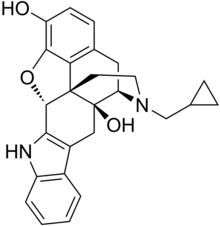Naltrindole is a highly potent, highly selective delta opioid receptor antagonist used in biomedical research. In May 2012 a paper was published in Nature with the structure of naltrindole in complex with the mouse δ-opioid G-protein coupled receptor, solved by X-ray crystallography.[1]
 | |
| Clinical data | |
|---|---|
| Routes of administration | IV |
| ATC code |
|
| Identifiers | |
| |
| CAS Number | |
| PubChem CID | |
| IUPHAR/BPS | |
| ChemSpider | |
| UNII | |
| ChEMBL | |
| CompTox Dashboard (EPA) | |
| Chemical and physical data | |
| Formula | C26H26N2O3 |
| Molar mass | 414.505 g·mol−1 |
| 3D model (JSmol) | |
| |
| |
| (verify) | |
Drug design
editSince peptide compounds are unable to cross the blood–brain barrier, researchers developed naltrindole to be a non-peptide antagonist analog of the delta-preferring endogenous opiate enkephalin. Enkephalin contains an aromatic phenyl group on its Phe4 residue, which was hypothesized to be the "address" sequence responsible for the opiate's delta opioid receptor affinity.[2] Thus, attachment of a phenyl-containing indole molecule to the C-ring of naltrexone's morphinan base successfully produced a drug with the high receptor affinity of naltrexone, but which binds almost exclusively to the delta opioid receptor.[3]
References
edit- ^ Granier S, Manglik A, Kruse AC, Kobilka TS, Thian FS, Weis WI, Kobilka BK (May 2012). "Structure of the δ-opioid receptor bound to naltrindole". Nature. 485 (7398): 400–4. Bibcode:2012Natur.485..400G. doi:10.1038/nature11111. PMC 3523198. PMID 22596164.
- ^ Lipkowski AW, Tam SW, Portoghese PS (July 1986). "Peptides as receptor selectivity modulators of opiate pharmacophores". Journal of Medicinal Chemistry. 29 (7): 1222–5. doi:10.1021/jm00157a018. PMID 2879914.
- ^ Portoghese PS, Sultana M, Takemori AE (January 1988). "Naltrindole, a highly selective and potent non-peptide delta opioid receptor antagonist". European Journal of Pharmacology. 146 (1): 185–6. doi:10.1016/0014-2999(88)90502-X. PMID 2832195.